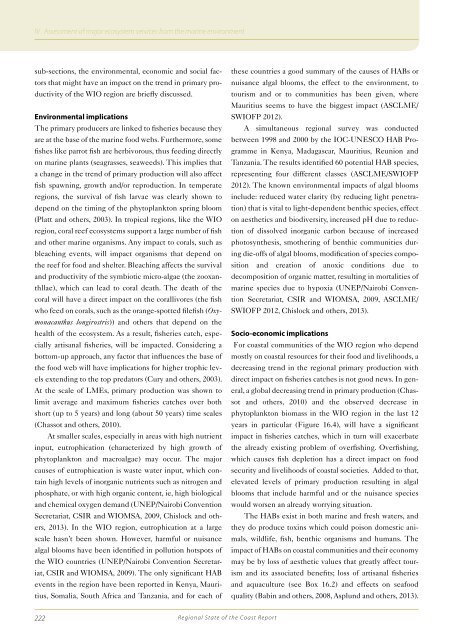WIOSOC2015_FinalDraft
WIOSOC2015_FinalDraft.pdf
WIOSOC2015_FinalDraft.pdf
Create successful ePaper yourself
Turn your PDF publications into a flip-book with our unique Google optimized e-Paper software.
IV . Assessment of major ecosystem services from the marine environment<br />
sub-sections, the environmental, economic and social factors<br />
that might have an impact on the trend in primary productivity<br />
of the WIO region are briefly discussed.<br />
Environmental implications<br />
The primary producers are linked to fisheries because they<br />
are at the base of the marine food webs. Furthermore, some<br />
fishes like parrot fish are herbivorous, thus feeding directly<br />
on marine plants (seagrasses, seaweeds). This implies that<br />
a change in the trend of primary production will also affect<br />
fish spawning, growth and/or reproduction. In temperate<br />
regions, the survival of fish larvae was clearly shown to<br />
depend on the timing of the phytoplankton spring bloom<br />
(Platt and others, 2003). In tropical regions, like the WIO<br />
region, coral reef ecosystems support a large number of fish<br />
and other marine organisms. Any impact to corals, such as<br />
bleaching events, will impact organisms that depend on<br />
the reef for food and shelter. Bleaching affects the survival<br />
and productivity of the symbiotic micro-algae (the zooxanthllae),<br />
which can lead to coral death. The death of the<br />
coral will have a direct impact on the corallivores (the fish<br />
who feed on corals, such as the orange-spotted filefish (Oxymonacanthus<br />
longirostris)) and others that depend on the<br />
health of the ecosystem. As a result, fisheries catch, especially<br />
artisanal fisheries, will be impacted. Considering a<br />
bottom-up approach, any factor that influences the base of<br />
the food web will have implications for higher trophic levels<br />
extending to the top predators (Cury and others, 2003).<br />
At the scale of LMEs, primary production was shown to<br />
limit average and maximum fisheries catches over both<br />
short (up to 5 years) and long (about 50 years) time scales<br />
(Chassot and others, 2010).<br />
At smaller scales, especially in areas with high nutrient<br />
input, eutrophication (characterized by high growth of<br />
phytoplankton and macroalgae) may occur. The major<br />
causes of eutrophication is waste water input, which contain<br />
high levels of inorganic nutrients such as nitrogen and<br />
phosphate, or with high organic content, ie, high biological<br />
and chemical oxygen demand (UNEP/Nairobi Convention<br />
Secretariat, CSIR and WIOMSA, 2009, Chislock and others,<br />
2013). In the WIO region, eutrophication at a large<br />
scale hasn’t been shown. However, harmful or nuisance<br />
algal blooms have been identified in pollution hotspots of<br />
the WIO countries (UNEP/Nairobi Convention Secretariat,<br />
CSIR and WIOMSA, 2009). The only significant HAB<br />
events in the region have been reported in Kenya, Mauritius,<br />
Somalia, South Africa and Tanzania, and for each of<br />
these countries a good summary of the causes of HABs or<br />
nuisance algal blooms, the effect to the environment, to<br />
tourism and or to communities has been given, where<br />
Mauritius seems to have the biggest impact (ASCLME/<br />
SWIOFP 2012).<br />
A simultaneous regional survey was conducted<br />
between 1998 and 2000 by the IOC-UNESCO HAB Programme<br />
in Kenya, Madagascar, Mauritius, Reunion and<br />
Tanzania. The results identified 60 potential HAB species,<br />
representing four different classes (ASCLME/SWIOFP<br />
2012). The known environmental impacts of algal blooms<br />
include: reduced water clarity (by reducing light penetration)<br />
that is vital to light-dependent benthic species, effect<br />
on aesthetics and biodiversity, increased pH due to reduction<br />
of dissolved inorganic carbon because of increased<br />
photosynthesis, smothering of benthic communities during<br />
die-offs of algal blooms, modification of species composition<br />
and creation of anoxic conditions due to<br />
decomposition of organic matter, resulting in mortalities of<br />
marine species due to hypoxia (UNEP/Nairobi Convention<br />
Secretariat, CSIR and WIOMSA, 2009, ASCLME/<br />
SWIOFP 2012, Chislock and others, 2013).<br />
Socio-economic implications<br />
For coastal communities of the WIO region who depend<br />
mostly on coastal resources for their food and livelihoods, a<br />
decreasing trend in the regional primary production with<br />
direct impact on fisheries catches is not good news. In general,<br />
a global decreasing trend in primary production (Chassot<br />
and others, 2010) and the observed decrease in<br />
phytoplankton biomass in the WIO region in the last 12<br />
years in particular (Figure 16.4), will have a significant<br />
impact in fisheries catches, which in turn will exacerbate<br />
the already existing problem of overfishing. Overfishing,<br />
which causes fish depletion has a direct impact on food<br />
security and livelihoods of coastal societies. Added to that,<br />
elevated levels of primary production resulting in algal<br />
blooms that include harmful and or the nuisance species<br />
would worsen an already worrying situation.<br />
The HABs exist in both marine and fresh waters, and<br />
they do produce toxins which could poison domestic animals,<br />
wildlife, fish, benthic organisms and humans. The<br />
impact of HABs on coastal communities and their economy<br />
may be by loss of aesthetic values that greatly affect tourism<br />
and its associated benefits; loss of artisanal fisheries<br />
and aquaculture (see Box 16.2) and effects on seafood<br />
quality (Babin and others, 2008, Asplund and others, 2013).<br />
222 Regional State of the Coast Report


















